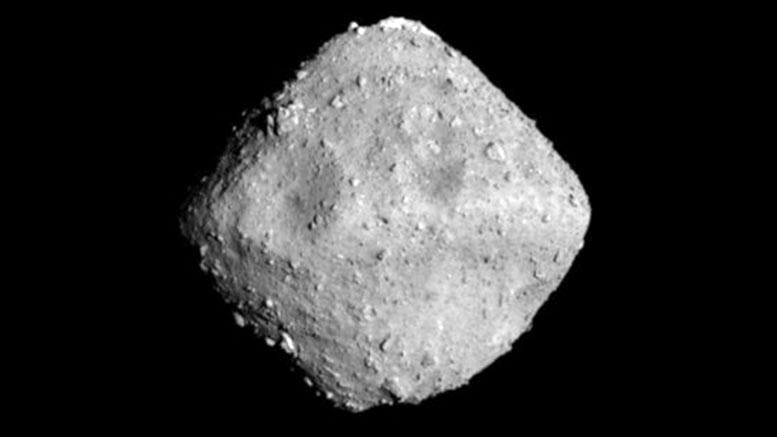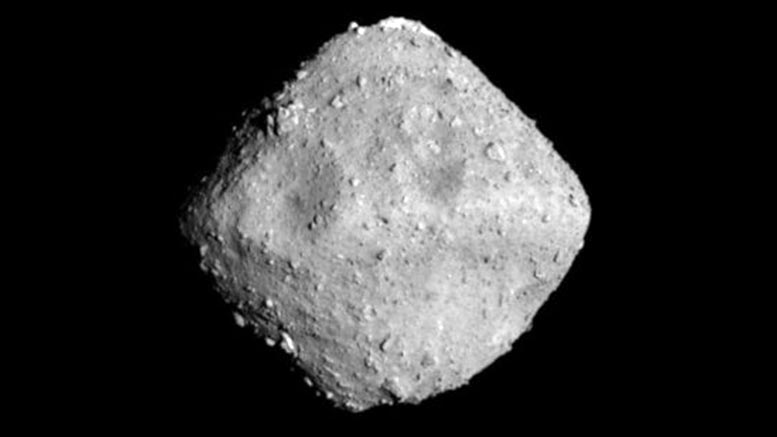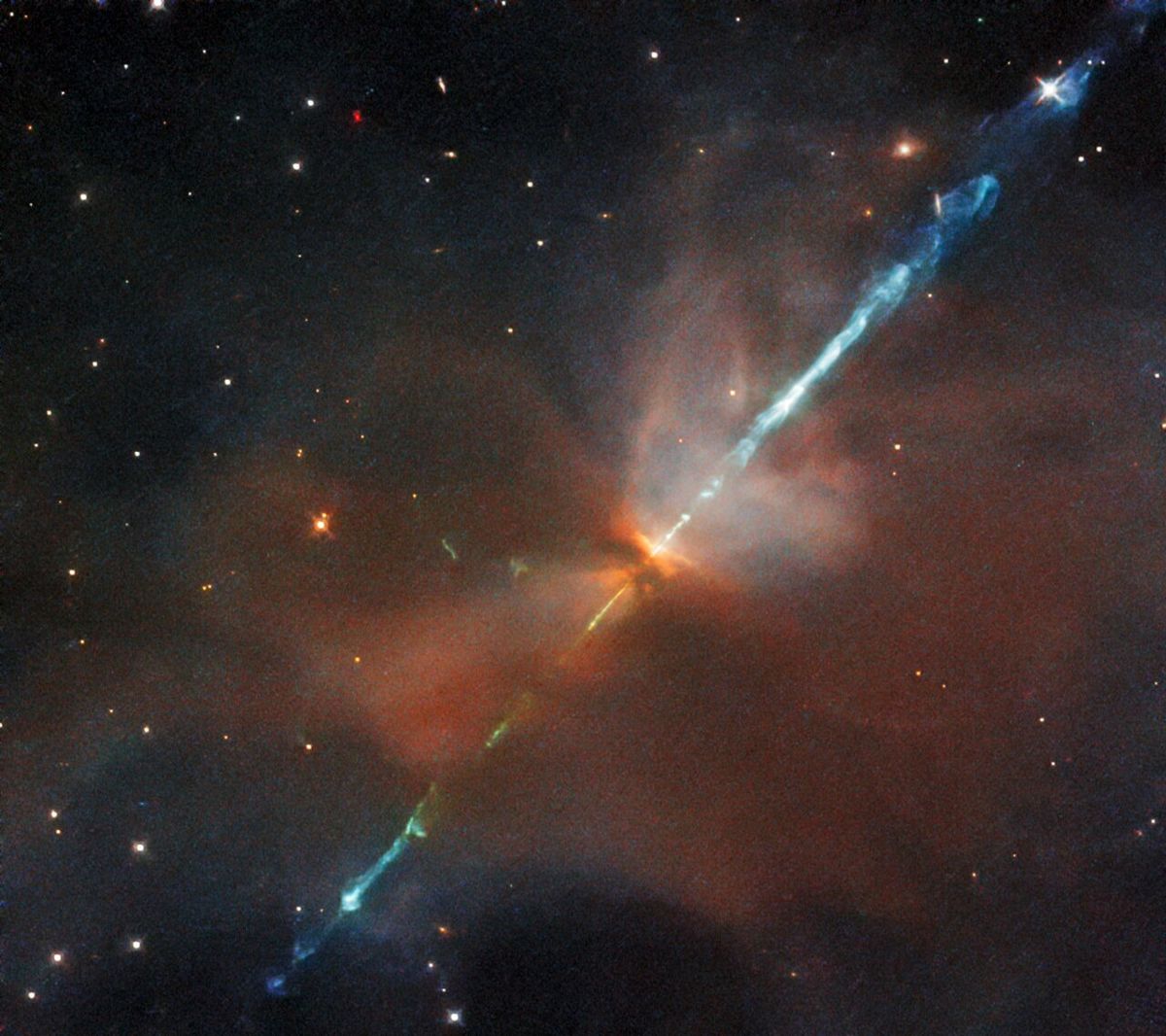
류구 소행성 – 이 이미지는 2018년 6월 26일에 20km에서 촬영되었으며 직경은 870m입니다. 크레딧: Hayabusa2/JAXA
대규모 국제 협력 사용[{” attribute=””>Diamond Light Source, the UK’s national synchrotron facility, to examine grains collected from a near-Earth asteroid in order to improve our understanding of the evolution of our solar system.
A team of researchers from the University of Leicester utilized Diamond Light Source’s Nanoprobe beamline I14, to perform a chemical analysis of a fragment of the Ryugu asteroid using X-ray Absorption Near Edge Spectroscopy (XANES). The detailed composition of the asteroid was studied by mapping out the chemical states of the elements within the asteroid material. Additionally, an electron microscope at Diamond’s electron Physical Science Imaging Centre (ePSIC) was used to examine the asteroid grains.
Julia Parker is the Principal Beamline Scientist for I14 at Diamond. She said: “The X-ray Nanoprobe allows scientists to examine the chemical structure of their samples at micron to nano lengthscales, which is complemented by the nano to atomic resolution of the imaging at ePSIC. It’s very exciting to be able to contribute to the understanding of these unique samples, and to work with the team at Leicester to demonstrate how the techniques at the beamline, and correlatively at ePSIC, can benefit future sample return missions.”

Image taken at E01 ePSIC of Ryugu serpentine and Fe oxide minerals. Credit: ePSIC/University of Leicester
The data collected at Diamond contributed to a wider study of the space weathering signatures on the asteroid. The pristine asteroid samples enabled the collaborators to explore how space weathering can alter the physical and chemical composition of the surface of carbonaceous asteroids like Ryugu.
The researchers discovered that the surface of Ryugu is dehydrated and that it is likely that space weathering is responsible. The findings of the study, recently published in Nature Astronomy, have led the authors to conclude that asteroids that appear dry on the surface may be water-rich, potentially requiring revision of our understanding of the abundances of asteroid types and the formation history of the asteroid belt.
Ryugu is a near-Earth asteroid, around 900 meters in diameter, first discovered in 1999 within the asteroid belt between Mars and Jupiter. It is named after the undersea palace of the Dragon God in Japanese mythology. In 2014, the Japanese state space agency JAXA launched Hayabusa2, an asteroid sample-return mission, to rendezvous with the Ryugu asteroid and collect material samples from its surface and sub-surface. The spacecraft returned to Earth in 2020, releasing a capsule containing precious fragments of the asteroid. These small samples were distributed to labs around the world for scientific study, including the University of Leicester’s School of Physics & Astronomy and Space Park where John Bridges, one of the authors on the paper, is a Professor of Planetary Science.
John said: “This unique mission to gather samples from the most primitive, carbonaceous, building blocks of the Solar System needs the world’s most detailed microscopy and that’s why JAXA and the Fine Grained Mineralogy team wanted us to analyze samples at Diamond’s X-ray nanoprobe beamline. We helped reveal the nature of space weathering on this asteroid with micrometeorite impacts and the solar wind creating dehydrated serpentine minerals, and an associated reduction from oxidized Fe3+ to more reduced Fe2+.
It’s important to build up experience in studying samples returned from asteroids, as in the Hayabusa2 mission, because soon there will be new samples from other asteroid types, the Moon and within the next 10 years Mars, returned to Earth. The UK community will be able to perform some of the critical analyses due to our facilities at Diamond and the electron microscopes at ePSIC.”
The building blocks of Ryugu are remnants of interactions between water, minerals, and organics in the early Solar System prior to the formation of Earth. Understanding the composition of asteroids can help explain how the early solar system developed, and subsequently how the Earth formed. They may even help explain how life on Earth came about, with asteroids believed to have delivered much of the planet’s water as well as organic compounds such as amino acids, which provide the fundamental building blocks from which all human life is constructed.
The information that is being gleaned from these tiny asteroid samples will help us to better understand the origin not only of the planets and stars but also of life itself. Whether it’s fragments of asteroids, ancient paintings, or unknown virus structures, at the synchrotron, scientists can study their samples using a machine that is 10,000 times more powerful than a traditional microscope.
Reference: “A dehydrated space-weathered skin cloaking the hydrated interior of Ryugu” by Takaaki Noguchi, Toru Matsumoto, Akira Miyake, Yohei Igami, Mitsutaka Haruta, Hikaru Saito, Satoshi Hata, Yusuke Seto, Masaaki Miyahara, Naotaka Tomioka, Hope A. Ishii, John P. Bradley, Kenta K. Ohtaki, Elena Dobrică, Hugues Leroux, Corentin Le Guillou, Damien Jacob, Francisco de la Peña, Sylvain Laforet, Maya Marinova, Falko Langenhorst, Dennis Harries, Pierre Beck, Thi H. V. Phan, Rolando Rebois, Neyda M. Abreu, Jennifer Gray, Thomas Zega, Pierre-M. Zanetta, Michelle S. Thompson, Rhonda Stroud, Kate Burgess, Brittany A. Cymes, John C. Bridges, Leon Hicks, Martin R. Lee, Luke Daly, Phil A. Bland, Michael E. Zolensky, David R. Frank, James Martinez, Akira Tsuchiyama, Masahiro Yasutake, Junya Matsuno, Shota Okumura, Itaru Mitsukawa, Kentaro Uesugi, Masayuki Uesugi, Akihisa Takeuchi, Mingqi Sun, Satomi Enju, Aki Takigawa, Tatsuhiro Michikami, Tomoki Nakamura, Megumi Matsumoto, Yusuke Nakauchi, Masanao Abe, Masahiko Arakawa, Atsushi Fujii, Masahiko Hayakawa, Naru Hirata, Naoyuki Hirata, Rie Honda, Chikatoshi Honda, Satoshi Hosoda, Yu-ichi Iijima, Hitoshi Ikeda, Masateru Ishiguro, Yoshiaki Ishihara, Takahiro Iwata, Kousuke Kawahara, Shota Kikuchi, Kohei Kitazato, Koji Matsumoto, Moe Matsuoka, Yuya Mimasu, Akira Miura, Tomokatsu Morota, Satoru Nakazawa, Noriyuki Namiki, Hirotomo Noda, Rina Noguchi, Naoko Ogawa, Kazunori Ogawa, Tatsuaki Okada, Chisato Okamoto, Go Ono, Masanobu Ozaki, Takanao Saiki, Naoya Sakatani, Hirotaka Sawada, Hiroki Senshu, Yuri Shimaki, Kei Shirai, Seiji Sugita, Yuto Takei, Hiroshi Takeuchi, Satoshi Tanaka, Eri Tatsumi, Fuyuto Terui, Ryudo Tsukizaki, Koji Wada, Manabu Yamada, Tetsuya Yamada, Yukio Yamamoto, Hajime Yano, Yasuhiro Yokota, Keisuke Yoshihara, Makoto Yoshikawa, Kent Yoshikawa, Ryohta Fukai, Shizuho Furuya, Kentaro Hatakeda, Tasuku Hayashi, Yuya Hitomi, Kazuya Kumagai, Akiko Miyazaki, Aiko Nakato, Masahiro Nishimura, Hiromichi Soejima, Ayako I. Suzuki, Tomohiro Usui, Toru Yada, Daiki Yamamoto, Kasumi Yogata, Miwa Yoshitake, Harold C. Connolly Jr, Dante S. Lauretta, Hisayoshi Yurimoto, Kazuhide Nagashima, Noriyuki Kawasaki, Naoya Sakamoto, Ryuji Okazaki, Hikaru Yabuta, Hiroshi Naraoka, Kanako Sakamoto, Shogo Tachibana, Sei-ichiro Watanabe and Yuichi Tsuda, 19 December 2022, Nature Astronomy.
DOI: 10.1038/s41550-022-01841-6

“요은 베이컨과 알코올에 대한 전문 지식을 가진 닌자입니다. 그의 탐험적인 성격은 다양한 경험을 통해 대중 문화에 대한 깊은 애정과 지식을 얻게 해주었습니다. 그는 자랑스러운 탐험가로서, 새로운 문화와 경험을 적극적으로 탐구하며, 대중 문화에 대한 그의 열정은 그의 작품 속에서도 느낄 수 있습니다.”

/cloudfront-us-east-2.images.arcpublishing.com/reuters/GFMNF5KEFNKXRMB5OUPECYXOAE.jpg)







